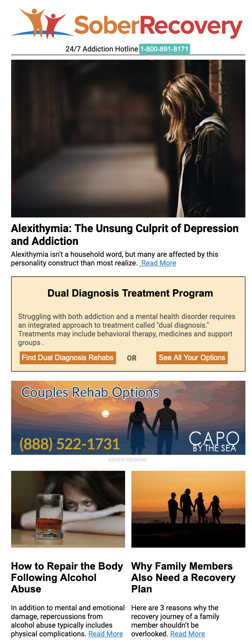Deadly Effects of Anorexia Del Valle TX
Substance abuse
Types of Care
Outpatient
Special Programs/Groups
Adolescents

(512) 472-4357
Services Provided
Substance abuse
Types of Care
Outpatient
Special Programs/Groups
Persons with co-occurring mental and substance abuse disorders, DUI/DWI offenders
Language Services
ASL or other assistance for hearing impaired, Spanish

Substance abuse , Halfway house
Types of Care
Residential long-term treatment (more than 30 days)
Special Programs/Groups
Persons with HIV/AIDS, Men, Criminal justice clients

Substance abuse
Types of Care
Hospital inpatient, Residential short-term treatment (30 days or less), Residential long-term treatment (more than 30 days)
Special Programs/Groups
Adolescents, Persons with co-occurring mental and substance abuse disorders
Language Services
Spanish

Substance abuse , Detoxification, Methadone Maintenance, Methadone Detoxification, Buprenorphine Services
Types of Care
Outpatient
Special Programs/Groups
Persons with co-occurring mental and substance abuse disorders, Pregnant/postpartum women, Women
Language Services
German, Spanish

Substance abuse , Halfway house
Types of Care
Residential long-term treatment (more than 30 days)

(512) 472-4357
Services Provided
Substance abuse , Methadone Maintenance, Methadone Detoxification, Buprenorphine Services
Types of Care
Outpatient
Language Services
ASL or other assistance for hearing impaired, Spanish

Substance abuse
Types of Care
Outpatient
Special Programs/Groups
Adolescents, Women, Criminal justice clients
Language Services
ASL or other assistance for hearing impaired, French, Spanish

Substance abuse
Types of Care
Outpatient
Language Services
Spanish

Substance abuse
Types of Care
Residential short-term treatment (30 days or less), Residential long-term treatment (more than 30 days), Outpatient, Partial hospitalization/day treatment
Special Programs/Groups
Adolescents, Gays and Lesbians, Pregnant/postpartum women, Criminal justice clients
Language Services
ASL or other assistance for hearing impaired, Spanish


Deadly Effects of Anorexia
In the modern world with fashion industry’s standards of beauty eating disorders are still on a balanced rise. “You can never be too thin” peer demands and daily magazine covers with ultra-thin models or stars make us only too conscious of our own flaws. What is not shown are the statistics: 20% of people with anorexia will end up dead. Anorexia nervosa, like most eating disorders, usually starts during puberty, but it can also affect adults and children. Recent studies indicate that the age of onset of anorexia is getting younger and younger, starting as early as 7 years of age. Though most commonly associated with teenage girls and adult women, it is estimated that 10% of reported cases of anorexia are boys and adult men. These numbers could be false, since anorexia is pegged as a “female disorder” and men might have difficulties admitting to the disease.People who have anorexia are obsessed with being thin and will usually go to any lengths to achieve and maintain this. They can’t see themselves through others’ eyes and often perceive themselves as fat. As a result, they will literally starve themselves in the name of “beauty”. Obsession with calorie counting, taking laxatives and diet pills or diuretics (drugs that elevate the amount of urine excretion), sometimes bulimia (inducing vomiting after a meal) and excessive exercising are the most common signs of this disease; as is hiding food or lying about food consumption. F...
Click here to read the rest of this article from Sober Recovery
Featured Facilities
Alpas Wellness La Plata, LLC is a medical organization with a Drug & Alcohol Treatment Center in Charles County, Maryland. Alpas Wellness offers Drug & Alcohol Addiction, Dual-Diagnosis & Mental Health Treatment to individuals struggling with addiction issues. Recovery is a whole-person journey, mind, body, and spirit. If underlying thinking and feeling processes are not identified and addressed, the risk of relapse increases. Holistic therapy is an evidence-based intervention for effectively treating the person, not simply the disorder.Alpas Wellness is committed to providing a patient-first experience at every encounter – from when you or a loved one picks up the phone or reaches out to the admissions team to when you graduate from an individualized treatment program – and every phase in between. From counseling and therapy to group support and medication-assisted interventions, evidence-based treatment protocols run the gamut of all that modern medicine offers. Continual reassessment of patient progress, treatment effectiveness, and symptom management is required to ensure all patient needs are met.It is not uncommon for substance use disorder sufferers to also suffer from mental health disorders. Co-occurring disorder treatment will address each condition individually to promote holistic healing. Genuinely effective treatment is a holistic process that addresses the mind, body, and soul. To achieve and maintain lasting recovery, completing a full continuum of care is critical.At Alpas Wellness, they’ve cultivated a welcoming and positive environment designed for distraction-free healing and recovery. They have collected an experienced and compassionate team of clinicians and providers to ensure every patient’s recovery experience is smooth and positive.Patient and Family-Centered Treatment For Lasting Recovery is their mission, call today for more information.
Lake Ariel Recovery Center, like all of the Sanctuary Health Group facilities, is a medically proven recovery facility that provides comprehensive treatment for substance use and co-occurring disorders. Sanctuary Health utilizes Everlasting Recovery, an approach that aligns our client’s recovery journey directly with their life, to extend recovery into a client’s lifestyle. Our unique approach establishes treatment as a daily practice, refocuses an individual away from addiction towards a healthier existence, and makes sustainable recovery achievable. Due to this integration, each client begins Everlasting Recovery by assessing their performance in various aspects of their lives via the bio, psycho, and social model. This initial assessment allows our therapists to craft a personal recovery program, which allows the greatest opportunity for our clients to suppress addiction and adopt recovery as a permanent identity. When attending Lake Ariel Recovery Center, our clients will establish life skills, implement daily routines for lifestyle recovery, and ignite a purpose for achieving better their lives. Through accomplishing these tasks, our clients will achieve sustainable recovery.
Addiction is a disease that no one should have to deal with alone. It is imperative that citizens of a city or county have access to top quality addiction treatment services. People from all walks of life can be susceptible to developing a substance use disorder in response to trauma they have endured, or lifestyle circumstances begetting maladaptive coping mechanisms.When a person is in the grips of addiction, they can become isolated and unable to see their condition for what it is—an illness that can be managed.Whether you are in Nashville or in the greater Nashville area such as Brentwood, Franklin, Hendersonville, etc, at Southeast Addiction, our outpatient addiction treatment programs offer something for individuals of all levels of commitment.
At Skywood, we are deeply invested in helping you regain your health. Our programming approach to recovery is designed with that in mind, from individual and group therapy to adventure therapy, art therapy and yoga. Each of these activities builds on the others to get to the root causes of addiction, introduce healthy new habits, address any co-occurring mental health issues and provide the mental and physical space you need in order to heal. We also provide access to regular 12-Step meetings and peer support groups. What we do at Skywood is different for several reasons. First, we treat addiction and mental health at the same time in a highly integrated way, looking to restore a person’s physical, emotional, mental and spiritual well-being. Second, we focus on resolving trauma, underlying issues and deep-rooted emotional pain that often causes substance abuse in the first place. Lastly, we emphasize life skills that help each person build a foundation for sustainable, long-term recovery.




